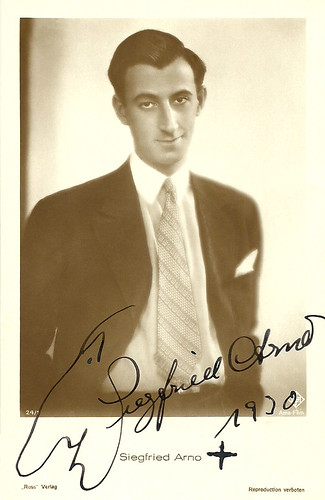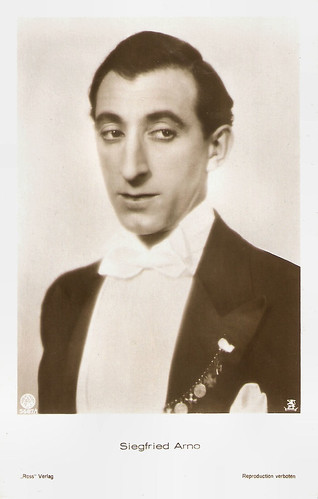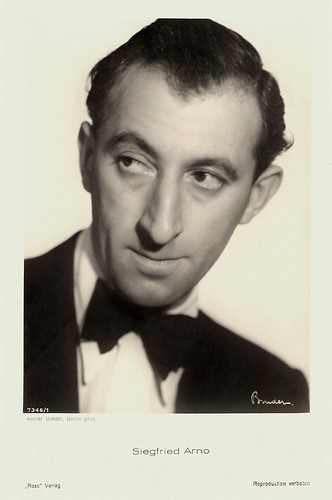Siegfried or Sig Arno (1895-1975) was regularly being referred to as the ‘German Charlie Chaplin’. The German-Jewish character actor appeared in ninety silent and early sound films before he had to flee Nazi-Germany. From 1939 on, he appeared as a supporting actor in over 50 Hollywood films, often as the ‘funny European’. He may be best remembered from The Palm Beach Story (Preston Sturges, 1942) as Toto, the nonsense-talking mustachioed man who hopelessly pursues Mary Astor's ‘Princess Centimillia’.

German postcard by Ross Verlag, no. 24/1. Photo: Ufa / Ama-Film. Collection: Didier Hanson.
Sig Arno was born Siegfried Aron in Hamburg, Germany, in 1895. He attended the Talmud Torah School in Hamburg and trained as a fashion designer at the Hamburger Kunstgewerbeschule (Hamburg school of applied arts).
He also was a member of the Hamburg theatre club, and from 1912 till 1914 he had his first employment at the Stadttheater Harburg and later at the Neuen Operettentheater in Hamburg. He went to work in Prague and Berlin. From 1922 on, he became a popular comedian in the Berlin theatres.
And soon he also became a star in the cinema. He went on to co-star in such silent German films as Die Frau von vierzig Jahren/The Wife of Forty Years (Richard Oswald, 1925) starring Diana Karenne, and as Lya de Putti’s husband in the Ufa production Manon Lescaut (Arthur Robison, 1926). He also appeared in the French silent film La danseuse Orchidée/The Orchid Dancer (Léonce Perret, 1928), featuring Louise Lagrange.
But he was most popular for his comic starring roles, such as in Schatz, mach' Kasse/Darling, Count the Cash (Felix Basch, 1926) with Ossi Oswalda, Familientag im Hause Prellstein/Family Gathering in the House of Prellstein (Hans Steinhoff, 1927), starring S.Z. Sakall, and Das Mädel mit der Peitsche/The Girl with the Whip (Carl Lamac, 1929) with Anny Ondra.
Initially his younger brother Bruno Arno appeared at his side. The tall, thin performer with his pronounced nose soon formed a double-act with the corpulent comedian Kurt Gerron and as ‘Beef and Steak’ they were regulars at the Kürfurstendam cabaret of comedians, the KaDeKo. They also co-starred in such silent comedies as Wir halten fest und treu zusammen/We Stick Together Through Thick and Thin (Herbert Nossen, 1929). It was an effort to create a German equivalent to Laurel and Hardy.
Arno also acted in such classic films as G.W. Pabst's Die Liebe der Jeanne Ney/The Love of Jeanne Ney (1927), Die Büchse der Pandora/Pandora's Box (1929) and Tagebuch einer Verlorenen/Diary of a Lost Girl (1929), the latter two starring Louise Brooks.
He again co-starred again with Anny Ondra in the early sound film Die vom Rummelplatz/Fairground People (Carl Lamac, 1930). The sound revolution had damaged Ondra's career in British films and led her to return to Germany. Die vom Rummelplatz showcased Ondra's talents as a musical comedy star who sings and dance.
A typical Jewish comedy was Keine Feier ohne Meyer/Without Meyer, No Celebration is Complete (Carl Boese, 1931). Arno played the ambitious young Jewish man Meyer, who tries to pass himself off as a successful business tycoon in order to marry into an upper-class family. Another was the farce Um eine Nasenlänge/ To a nose (Johannes Guter, 1931). Siegfried Arno maintained his commitment to stage and cabaret work and, in 1930 he was cast in the premiere of the acclaimed revue Im weißen Rößl (The White Horse Inn) at Berlin’s Großes Schauspielhaus, alongside Max Hansen and Camilla Spira.

German postcard by Ross Verlag, no. 5687/1, 1930-1931.

German postcard by Ross Verlag, no. 7346/1, 1932-1933. Photo: Alex Binder.
In 1933, after the fire in the Reichstag, Siegfried Arno had to leave the country due to the rise of Hitler. His posters had become the target of anti-Semitic graffiti. He worked in cabarets and theatres in the Netherlands, Belgium, Switzerland, Italy, Spain and Portugal. In the Netherlands he had an extended spell with fellow KaDeKo performer Willy Rosen’s ‘Theater der Prominenten’ troupe. Here he reunited with his double-act partner Kurt Gerron.
In Portugal he worked with other German exiles on the romantic comedy Gado Bravo/Wild Cattle (António Lopes Ribeiro, Max Nosseck, 1934), one of the first Portuguese sound films, starring Nita Brandao. In Belgium he directed the film comedy De roem van het regiment/The fame of the regiment (1936). He stayed in Europe until 1939, and then moved to Hollywood.
He got a small part in The Hunchback of Notre Dame (William Dieterle, 1939) starring Charles Laughton as Quasimodo. During the next twenty years Siegfried Arno appeared in over fifty films in Hollywood. Among his best known films are The Great Dictator (Charles Chaplin, 1940), Tales of Manhattan (Julien Duvivier, 1942) and The Palm Beach Story (Preston Sturges, 1942).
His thick accent limited him to supporting roles. With expert comic timing, he played waiters with funny accents in many enjoyable Hollywood films of the 1940s.
Arno also appeared three times on Broadway, in the musical Song of Norway (1944-1946), the play Time Remembered (1957-1958), based on Jean Anouilh’s play Léocadia, for which he was nominated for a Tony Award as Best Featured Actor in a Play in 1958, and the play The Cold Wind and the Warm (1958-1959).
From 1955 on, he again appeared regularly in the German and Austrian theatres. In 1966, Arno won a Filmband in Gold (the honorary German film award) "for his continued outstanding individual contributions to the German film over the years." Arno was also a successful portrait painter.
He was married three times. His wives were actress Lia (Caroline) Dahms (1922–1932, ended in divorce), Barbara Kiranoff (1934–1953, ended in divorce) and Austrian actress Kitty Mattern (1953–1975, ended with his death). With Dahms he had a son, costume and set-designer Peter Arno (1926).
Siegfried Arno died from Parkinson's disease in Woodland Hills, Los Angeles, in 1975, aged 79.
Trude Berliner & Siegfried Arno in Musikstadt Berlin 1931 (1931). Source: Jozef Sterkens (YouTube).
Sources: Jörg Schöning (CineGraph – German), Brendon Nash (Cabaret Berlin), Hal Erickson (AllMovie), José L Bernabé Tronchoni (Find A Grave), Internet Broadway Database, Wikipedia (English and German), and IMDb.

German postcard by Ross Verlag, no. 24/1. Photo: Ufa / Ama-Film. Collection: Didier Hanson.
The tall, thin performer with his pronounced nose
Sig Arno was born Siegfried Aron in Hamburg, Germany, in 1895. He attended the Talmud Torah School in Hamburg and trained as a fashion designer at the Hamburger Kunstgewerbeschule (Hamburg school of applied arts).
He also was a member of the Hamburg theatre club, and from 1912 till 1914 he had his first employment at the Stadttheater Harburg and later at the Neuen Operettentheater in Hamburg. He went to work in Prague and Berlin. From 1922 on, he became a popular comedian in the Berlin theatres.
And soon he also became a star in the cinema. He went on to co-star in such silent German films as Die Frau von vierzig Jahren/The Wife of Forty Years (Richard Oswald, 1925) starring Diana Karenne, and as Lya de Putti’s husband in the Ufa production Manon Lescaut (Arthur Robison, 1926). He also appeared in the French silent film La danseuse Orchidée/The Orchid Dancer (Léonce Perret, 1928), featuring Louise Lagrange.
But he was most popular for his comic starring roles, such as in Schatz, mach' Kasse/Darling, Count the Cash (Felix Basch, 1926) with Ossi Oswalda, Familientag im Hause Prellstein/Family Gathering in the House of Prellstein (Hans Steinhoff, 1927), starring S.Z. Sakall, and Das Mädel mit der Peitsche/The Girl with the Whip (Carl Lamac, 1929) with Anny Ondra.
Initially his younger brother Bruno Arno appeared at his side. The tall, thin performer with his pronounced nose soon formed a double-act with the corpulent comedian Kurt Gerron and as ‘Beef and Steak’ they were regulars at the Kürfurstendam cabaret of comedians, the KaDeKo. They also co-starred in such silent comedies as Wir halten fest und treu zusammen/We Stick Together Through Thick and Thin (Herbert Nossen, 1929). It was an effort to create a German equivalent to Laurel and Hardy.
Arno also acted in such classic films as G.W. Pabst's Die Liebe der Jeanne Ney/The Love of Jeanne Ney (1927), Die Büchse der Pandora/Pandora's Box (1929) and Tagebuch einer Verlorenen/Diary of a Lost Girl (1929), the latter two starring Louise Brooks.
He again co-starred again with Anny Ondra in the early sound film Die vom Rummelplatz/Fairground People (Carl Lamac, 1930). The sound revolution had damaged Ondra's career in British films and led her to return to Germany. Die vom Rummelplatz showcased Ondra's talents as a musical comedy star who sings and dance.
A typical Jewish comedy was Keine Feier ohne Meyer/Without Meyer, No Celebration is Complete (Carl Boese, 1931). Arno played the ambitious young Jewish man Meyer, who tries to pass himself off as a successful business tycoon in order to marry into an upper-class family. Another was the farce Um eine Nasenlänge/ To a nose (Johannes Guter, 1931). Siegfried Arno maintained his commitment to stage and cabaret work and, in 1930 he was cast in the premiere of the acclaimed revue Im weißen Rößl (The White Horse Inn) at Berlin’s Großes Schauspielhaus, alongside Max Hansen and Camilla Spira.

German postcard by Ross Verlag, no. 5687/1, 1930-1931.

German postcard by Ross Verlag, no. 7346/1, 1932-1933. Photo: Alex Binder.
The target of anti-Semitic graffiti
In 1933, after the fire in the Reichstag, Siegfried Arno had to leave the country due to the rise of Hitler. His posters had become the target of anti-Semitic graffiti. He worked in cabarets and theatres in the Netherlands, Belgium, Switzerland, Italy, Spain and Portugal. In the Netherlands he had an extended spell with fellow KaDeKo performer Willy Rosen’s ‘Theater der Prominenten’ troupe. Here he reunited with his double-act partner Kurt Gerron.
In Portugal he worked with other German exiles on the romantic comedy Gado Bravo/Wild Cattle (António Lopes Ribeiro, Max Nosseck, 1934), one of the first Portuguese sound films, starring Nita Brandao. In Belgium he directed the film comedy De roem van het regiment/The fame of the regiment (1936). He stayed in Europe until 1939, and then moved to Hollywood.
He got a small part in The Hunchback of Notre Dame (William Dieterle, 1939) starring Charles Laughton as Quasimodo. During the next twenty years Siegfried Arno appeared in over fifty films in Hollywood. Among his best known films are The Great Dictator (Charles Chaplin, 1940), Tales of Manhattan (Julien Duvivier, 1942) and The Palm Beach Story (Preston Sturges, 1942).
His thick accent limited him to supporting roles. With expert comic timing, he played waiters with funny accents in many enjoyable Hollywood films of the 1940s.
Arno also appeared three times on Broadway, in the musical Song of Norway (1944-1946), the play Time Remembered (1957-1958), based on Jean Anouilh’s play Léocadia, for which he was nominated for a Tony Award as Best Featured Actor in a Play in 1958, and the play The Cold Wind and the Warm (1958-1959).
From 1955 on, he again appeared regularly in the German and Austrian theatres. In 1966, Arno won a Filmband in Gold (the honorary German film award) "for his continued outstanding individual contributions to the German film over the years." Arno was also a successful portrait painter.
He was married three times. His wives were actress Lia (Caroline) Dahms (1922–1932, ended in divorce), Barbara Kiranoff (1934–1953, ended in divorce) and Austrian actress Kitty Mattern (1953–1975, ended with his death). With Dahms he had a son, costume and set-designer Peter Arno (1926).
Siegfried Arno died from Parkinson's disease in Woodland Hills, Los Angeles, in 1975, aged 79.
Trude Berliner & Siegfried Arno in Musikstadt Berlin 1931 (1931). Source: Jozef Sterkens (YouTube).
Sources: Jörg Schöning (CineGraph – German), Brendon Nash (Cabaret Berlin), Hal Erickson (AllMovie), José L Bernabé Tronchoni (Find A Grave), Internet Broadway Database, Wikipedia (English and German), and IMDb.
No comments:
Post a Comment